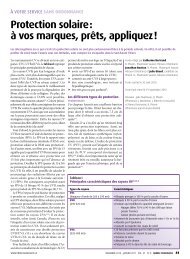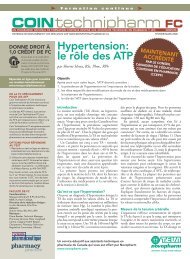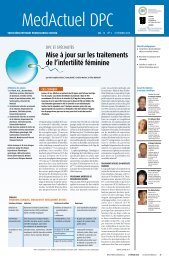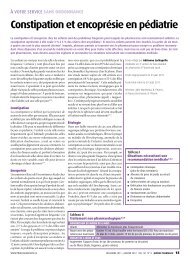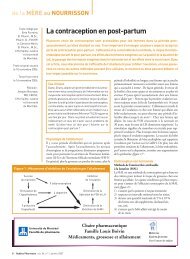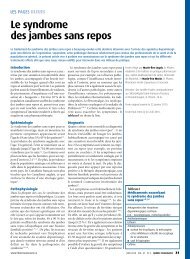La cessation et la substitution d'un antidépresseur - Profession Santé
La cessation et la substitution d'un antidépresseur - Profession Santé
La cessation et la substitution d'un antidépresseur - Profession Santé
- No tags were found...
Create successful ePaper yourself
Turn your PDF publications into a flip-book with our unique Google optimized e-Paper software.
<strong>La</strong> <strong>cessation</strong> <strong>et</strong> <strong>la</strong> <strong>substitution</strong> d’un antidépresseurdépresseur, puisqu’une association peutentraîner une grave toxicité, par exempleune crise hypertensive ou un syndromesérotoninergique. (Rappelons que lesIMAO agissent en inhibant de façon complètepour environ 10 à 14 jours les enzymesresponsables de <strong>la</strong> dégradation de <strong>la</strong>sérotonine, de <strong>la</strong> noradrénaline <strong>et</strong> de <strong>la</strong>dopamine dans <strong>la</strong> fente synaptique 29 . )C<strong>et</strong>te même précaution doit être priselors du passage d’un IMAO à un autreIMAO. Dans le cas contraire où l’on doitcesser un autre antidépresseur pour débuterun IMAO, il est nécessaire d’attendrecinq demi-vies du médicament cessé, entenant compte des métabolites actifs,avant de débuter l’IMAO. Il s’agit dans lecas de <strong>la</strong> fluoxétine d’une période de cinqsemaines 7,26,28 .MoclobémideLors du passage du moclobémide à unautre antidépresseur, il est conseillé d’attendredeux à trois jours avant de débuterle nouveau médicament 18,22 .Le tableau III suggère des stratégies de<strong>substitution</strong> pour les différents antidépresseursselon les données recensées dans <strong>la</strong>documentation médicale. Le tableau IVprésente les doses équivalentes des ISRS <strong>et</strong>de <strong>la</strong> ven<strong>la</strong>faxine.Conseils aux patientsIl est important d’éduquer le patient sur lemode de fonctionnement des antidépresseurs,sur l’importance de compléter le traitement<strong>et</strong> de lui expliquer les raisons deprendre chaque dose de médicament (éviteles symptômes d’interruption <strong>et</strong> augmentel’efficacité du traitement) 30 . Il faut que lepatient s’attende à un dé<strong>la</strong>i d’action d’environquatre semaines, mais il doit savoir queles eff<strong>et</strong>s indésirables peuvent apparaître dèsle début du traitement 30 . Il faut égalementlui conseiller de parler à son médecin ou àson pharmacien avant de cesser sa médication30 . Ainsi, il est important d’informer lespatients des risques de symptômes de r<strong>et</strong>raitdès le début du traitement afin d’éviterqu’ils ne l’interrompent sans consulter 7,13,14 .C<strong>et</strong>te mesure peut également aider à réduirel’anxiété lorsque les symptômes de r<strong>et</strong>raitsurviennent 7 . Le pharmacien peut en outresuperviser <strong>la</strong> <strong>cessation</strong> <strong>et</strong> <strong>la</strong> <strong>substitution</strong>d’un antidépresseur <strong>et</strong> assister le patient aucours du processus en le rassurant <strong>et</strong> en luiprocurant des conseils importants.ConclusionIl existe peu de données probantes dans <strong>la</strong>documentation médicale pour guider lescliniciens quand vient le temps de cesserun antidépresseur ou de le changer 2,9 . Desexperts ont tenté de proposer des méthodesafin d’aider les cliniciens <strong>et</strong> leurspatients. Les données présentées dans c<strong>et</strong>article se veulent un guide pour encadrer <strong>la</strong>gestion délicate de ces médicaments tantutilisés. Il faut garder en tête que, lorsquevient le temps d’apporter des changementsdans <strong>la</strong> médication, il s’agit plus d’art quede science. Il faut se rappeler que chaquepatient est unique <strong>et</strong> qu’il nous faudraindividualiser notre méthode pour chacund’eux. nRéférences1. Lejoyeux M, Adès J. Antidepressant Discontinuation: A Review of the literature. J Clin Psychiatry1997; 58 (suppl 7): 11-6.2. Haddad PM. Antidepressant Discontinuation Syndromes.Clinical Relevance, Prevention and Management,Drug Saf 2001; 24 (3): 183-97.3. Warner CH, Bobo W, Carolynn W <strong>et</strong> coll. AntidepressantDiscontinuation Syndrome. Am Fam Physician2006; 74(3): 449-56.4. Schatzberg AF, Haddad P, Kap<strong>la</strong>n EM. SerotoninReuptake Inhibitor Discontinuation Syndrome: AHypoth<strong>et</strong>ical Definition. J Clin Psychiatry 1997; 58(suppl 7): 5-10.5. Schatzberg AF. Antidepressant DiscontinuationSyndrome : An Update on Serotonin Reuptake Inhibitors.J Clin Psychiatry 1997; 58 (suppl 7): 3-4.6. Van Geffen ECG, Hugtenberg JG, Heerding ER <strong>et</strong>coll. Discontinuation symptoms in users of selectiveserotonin reuptake inhibitors in clinical practice:tapering versus abrupt discontinuation. Eur JClin Pharmacol 2005; 61: 303-7.7. Hirsch M, Birnbaum RJ. Antidepressant medicationin adults : Switching and discontinuing medication.UpToDate. Dernière modification: 27 septembre2007. [En ligne. Consulté en ligne le 8avril 2008.] www.uptodate.com.8. Haddad P. Newer Antidepressants and the DiscontinuationSyndrome. J Clin Psychiatry 1997; 58(suppl 7): 17-22.9. Shelton RC. The Nature of the DiscontinuationSyndrome Associated With Antidepressant Drugs.J Clin Psychiatry 2006; 67(suppl 4): 3-7.10. Lusignan E. Comment reconnaître un syndromed’interruption associé aux antidépresseurs? QuébecPharmacie 2002: 49(10): 854-5.11. Schatzberg AF, Haddad P, Kap<strong>la</strong>n EM <strong>et</strong> coll.Possible Biological Mechanisms of the SerotoninInhibitor Discontinuation syndrome. J Clin Psychiatry1997; 58(suppl 7): 23-7.12. Masand PS, Gupta S. Long-Term side Effects ofNewer-Generation Antidepressants: SSRIS, Ven<strong>la</strong>faxine,Nefazodone, Bupropion, and Mirtazapine.Annals of Clinical Psychiatry 2002: 14(3): 175-82.13. Dal<strong>la</strong>ire S, Morrison H. Réactions de sevrage à <strong>la</strong>paroxétine <strong>et</strong> aux autres ISRS. Bull Can EIM 2003;13(2): 1-2.14. Rosenbaum JF, Zajecka J. Clinical Managementof Antidepressant Discontinuation. J Clin Psychiatry1997; 58(suppl 7): 37-40.15. Macdonald L. Réactions liées à l’arrêt du traitementaux ISRS. Bull Can EIM 1998; 8(4): 2-4.16. Finley PR, <strong>La</strong>vid LY, Benefield WH Jr. Mood DisordersI : Major Depressive Disorders. Dans: Koda-Kimble MA, Yonf LY. Applied Therapeutics, The clinicaluse of drugs, 8 th ed. Lippincott, William &Wilkins, Phi<strong>la</strong>delphie, 2005: 79-1 -79-37.17. American Psychiatric Association. Practice Guidelinefor the Treatment of Patients With MajorDepressive Disorders (Revision). Am J Psychiatry2000; 157(suppl 4): 1-45.18. Bezchlibnyk-Butler K, Jeffries JJ, éd. ClinicalHandbook of Psychotropic Drugs, 16 th ed. Hogrefe& Huber, 2006.19. Fava M, Mulroy R, Alpert J <strong>et</strong> coll. Emergence ofadverse events following discontinuation of treatmentwith extended-release ven<strong>la</strong>faxine. Am JPsychiatry 1997; 154(12): 1760-2.20. Perahia DG, Kajdasz DK, Desaiah D <strong>et</strong> coll.Symptoms following abrupt discontinuation ofdulox<strong>et</strong>ine treatment in patients with majordepressive disorder. J Affect Disord 2005; 89(1-3):207-12.21. Berber, MJ. FINISH: Remembering the Discontinuationsyndrome. J Clin Psychiatry 1998; 59(5): 255.22. Canadian Psychiatric Association: CanadianN<strong>et</strong>work for Mood and Anxi<strong>et</strong>y Treatments (CAN-MAT). Clinical Guidelines for the Treatment ofDepressive Disorders. Can J Psychiatry 2001;46(suppl 1): 5S-90S.23. Burry L, Kennie N. Withdrawal reactions. Pharmacypractice 2000; 16(4): 46-54.24. Joffe RT, Gardner DM, Kutcher SP. Guide desmédicaments psychotropes: deuxième édition.MDH Consulting Inc., Macham, Ontario, 2002.25. Fava M. Management of Nonresponse and Intolerence: Switching Strategies. J Clin Psychiatry2000; 61(suppl 2): 10-2.26. Marangell LB. Switching Antidepressants forTreatment-Resistant Major Depression. J Clin Psychiatry2001; 62(suppl 18):12-7.27. Nelson JC. Managing Treatment-Resistant MajorDepression. J Clin Psychiatry 2003; 64(suppl 1): 5-12.28. Anonyme. How to Switch Antidepressants. Pharmacist’sL<strong>et</strong>ter 2006; 22(6): 220605.29. Légaré N. Mise à jour sur le traitement pharmacologiquede <strong>la</strong> dépression majeure. Québec Pharmacie2008; 55(6) : 21-8.30. Kap<strong>la</strong>n EM. Antidepressant Noncompliance as aFactor in the Discontinuation Syndrome. J Clin Psychiatry1997; 58(suppl 7): 31-6.31. Kando JC, Wells BG, Hayes PE. Depressives Disorders.Dans: Dipiro JT, Talbert RL, Yee GC, <strong>et</strong> coll.Pharmacotherapy, A Pathophysiological Approach,5 th ed. Mc Graw-Hill, NY, 2002:1243-64.32. Cassem NH, Papakostas GI, Fava M <strong>et</strong> coll.Mood-Disordered Patients. Dans : Stern TA, FricchioneGL, Caasem NH, <strong>et</strong> coll. Massachus<strong>et</strong>tsGeneral Hospital Handbook of General HospitalPsychiatry, 5 th ed. Massachus<strong>et</strong>ts General Hospital,Boston, 2004. 128 p.www.monportailpharmacie.caoctobre 2008 vol. 55 n° 9 Québec Pharmacie 31



